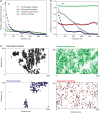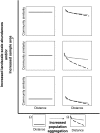A general framework for the distance-decay of similarity in ecological communities
- PMID: 18494792
- PMCID: PMC2613237
- DOI: 10.1111/j.1461-0248.2008.01202.x
A general framework for the distance-decay of similarity in ecological communities
Abstract
Species spatial turnover, or beta-diversity, induces a decay of community similarity with geographic distance known as the distance-decay relationship. Although this relationship is central to biodiversity and biogeography, its theoretical underpinnings remain poorly understood. Here, we develop a general framework to describe how the distance-decay relationship is influenced by population aggregation and the landscape-scale species-abundance distribution. We utilize this general framework and data from three tropical forests to show that rare species have a weak influence on distance-decay curves, and that overall similarity and rates of decay are primarily influenced by species abundances and population aggregation respectively. We illustrate the utility of the framework by deriving an exact analytical expression of the distance-decay relationship when population aggregation is characterized by the Poisson Cluster Process. Our study provides a foundation for understanding the distance-decay relationship, and for predicting and testing patterns of beta-diversity under competing theories in ecology.
Figures




 appear log-normal (in Yasuni) to right-skewed log-normal (in BCI and Korup); plotted on a linear scale, they are characterized by left-skewed shapes similar to those observed by Plotkin et al. (2000) (their fig. 5; see Appendix SE). (b–c) The distributions of number of clumps ρA0 and number of individuals per clump μ vary greatly between forests: species with few clusters and many individuals per cluster are common in Korup, but scarce in Yasuni, where species tend to be clumped in more clusters with fewer individuals. (d) Topographic maps and typical spatial distributions for trees in Yasuni, BCI and Korup.
appear log-normal (in Yasuni) to right-skewed log-normal (in BCI and Korup); plotted on a linear scale, they are characterized by left-skewed shapes similar to those observed by Plotkin et al. (2000) (their fig. 5; see Appendix SE). (b–c) The distributions of number of clumps ρA0 and number of individuals per clump μ vary greatly between forests: species with few clusters and many individuals per cluster are common in Korup, but scarce in Yasuni, where species tend to be clumped in more clusters with fewer individuals. (d) Topographic maps and typical spatial distributions for trees in Yasuni, BCI and Korup.
 (b) the number of clumps ρA0, (c) the mean number of individuals per clump μ and (d) the relative neighbourhood density Ω0-10 on a species’ abundance n. All correlations are significant (Spearman test, P < 0.05); b-values correspond to the slope of the log–log regression of the parameters against abundance.
(b) the number of clumps ρA0, (c) the mean number of individuals per clump μ and (d) the relative neighbourhood density Ω0-10 on a species’ abundance n. All correlations are significant (Spearman test, P < 0.05); b-values correspond to the slope of the log–log regression of the parameters against abundance.
Similar articles
-
Distance-decay differs among vertical strata in a tropical rainforest.J Anim Ecol. 2019 Jan;88(1):114-124. doi: 10.1111/1365-2656.12902. Epub 2018 Sep 24. J Anim Ecol. 2019. PMID: 30146776
-
Patterns of relative species abundance in rainforests and coral reefs.Nature. 2007 Nov 1;450(7166):45-9. doi: 10.1038/nature06197. Nature. 2007. PMID: 17972874
-
Moving beyond abundance distributions: neutral theory and spatial patterns in a tropical forest.Proc Biol Sci. 2015 Mar 7;282(1802):20141657. doi: 10.1098/rspb.2014.1657. Proc Biol Sci. 2015. PMID: 25631991 Free PMC article.
-
Species abundance, urn models, and neutrality.C R Biol. 2024 Oct 2;347:119-135. doi: 10.5802/crbiol.162. C R Biol. 2024. PMID: 39354840 Review.
-
Neutral macroecology.Science. 2001 Sep 28;293(5539):2413-8. doi: 10.1126/science.293.5539.2413. Science. 2001. PMID: 11577228 Review.
Cited by
-
Phylogenetic beta diversity in bacterial assemblages across ecosystems: deterministic versus stochastic processes.ISME J. 2013 Jul;7(7):1310-21. doi: 10.1038/ismej.2013.30. Epub 2013 Feb 28. ISME J. 2013. PMID: 23446837 Free PMC article.
-
Environmental Factors, More Than Spatial Distance, Explain Community Structure of Soil Ammonia-Oxidizers in Wetlands on the Qinghai-Tibetan Plateau.Microorganisms. 2020 Jun 21;8(6):933. doi: 10.3390/microorganisms8060933. Microorganisms. 2020. PMID: 32575850 Free PMC article.
-
Ocean Aerobiology.Front Microbiol. 2021 Oct 29;12:764178. doi: 10.3389/fmicb.2021.764178. eCollection 2021. Front Microbiol. 2021. PMID: 34777320 Free PMC article. Review.
-
Assembly mechanisms, not species pool, shape β-diversity of soil methanotrophic communities in steppes of China.Front Microbiol. 2025 Jan 20;15:1522319. doi: 10.3389/fmicb.2024.1522319. eCollection 2024. Front Microbiol. 2025. PMID: 39902288 Free PMC article.
-
What is macroecology?Biol Lett. 2012 Dec 23;8(6):904-6. doi: 10.1098/rsbl.2012.0672. Epub 2012 Aug 22. Biol Lett. 2012. PMID: 22915630 Free PMC article.
References
-
- Brown JH, Mehlman DW, Stevens GC. Spatial variation in abundance. Ecology. 1995;76:2028–2043.
-
- Chave J, Leigh EG. A spatially explicit neutral model of beta-diversity in tropical forests. Theor. Popul. Biol. 2002;62:153–168. - PubMed
-
- Condit R, Ashton PS, Baker P, Bunyavejchewin S, Gunatilleke S, Gunatilleke N, et al. Spatial patterns in the distribution of tropical tree species. Science. 2000;288:1414–1418. - PubMed
-
- Condit R, Pitman N, Leigh EG, Chave J, Terborgh J, Foster RB, et al. Beta-diversity in tropical forest trees. Science. 2002;295:666–669. - PubMed
Publication types
MeSH terms
LinkOut - more resources
Full Text Sources

